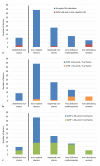Non-Invasive Zinc Protoporphyrin Screening Offers Opportunities for Secondary Prevention of Iron Deficiency in Blood Donors
- PMID: 37767275
- PMCID: PMC10521216
- DOI: 10.1159/000528545
Non-Invasive Zinc Protoporphyrin Screening Offers Opportunities for Secondary Prevention of Iron Deficiency in Blood Donors
Abstract
Background: Frequent blood donors are at high risk of developing iron deficiency. Currently, there is no potent screening during blood donation to detect iron deficient erythropoiesis (IDE) before anemia develops and deferral from donation is inevitable.
Study design and methods: In addition to capillary and venous hemoglobin, the iron status of 99 frequent blood donors was assessed by various venous blood parameters and zinc protoporphyrin IX (ZnPP). ZnPP was determined by high-performance liquid chromatography (HPLC) and a new prototype fiber-optic device was employed for non-invasive measurements of ZnPP through the blood collection tubing (NI-tubing) and on lip tissue (NI-lip). We aimed to evaluate the feasibility and diagnostic value of the NI-tubing measurement for early detection of severe iron deficiency in blood donors.
Results: NI-tubing and HPLC reference measurements of ZnPP showed narrow limits of agreement of 12.2 μmol ZnPP/mol heme and very high correlation (Spearman's Rho = 0.938). Using a cutoff of 65 μmol ZnPP/mol heme, NI-tubing measurements (n = 93) identified 100% of donors with iron deficiency anemia (IDA) and an additional 38% of donors with IDE. Accordingly, NI-tubing measurements would allow detection and selective protection of particularly vulnerable donors.
Conclusion: NI-tubing measurements are an accurate and simple method to implement ZnPP determination into the routine blood donation process. ZnPP was able to identify the majority of subjects with IDE and IDA and might therefore be a valuable tool to provide qualified information to donors about dietary measures and adjustments of the donation interval and thereby help to prevent IDA and hemoglobin deferral in the future.
Keywords: Anemia; Blood donation; Erythropoiesis; Iron deficiency; Zinc protoporphyrin.
Copyright © 2023 by The Author(s). Published by S. Karger AG, Basel.
Conflict of interest statement
A.S., A.L., L.H., M.V., and R.S. have disclosed no conflicts of interest. CH is shareholder and managing director of the start-up company FerroSens GmbH (Munich, Germany), which aims at commercializing the technology for NI detection of ZnPP. C.H., G.H., and H.S. are co-inventors of the patent family with application number PCT/EP2016/053389 “Apparatus and method for fluorescence measurements on tissue for the determination of blood fluorophores.” F.W. and E.Q. are affiliated to the company “Blutspendedienst des Bayerischen Roten Kreuzes gemeinnützige GmbH” (Munich, Germany).
Figures




References
-
- Myers DJ, Collins RA. Blood donation. Treasure island (FL) StatPearls. 2020 Available from: https://www.ncbi.nlm.nih.gov/books/NBK525967/
-
- Bundesärztekammer (BÄK). Beschluss der Bundesärztekammer über die Richtlinie zur Gewinnung von Blut und Blutbestandteilen und zur Anwendung von Blutprodukten (Richtlinie Hämotherapie) − Gesamtnovelle 2017. Dtsch Arztebl. 2017;114((3132)):A-1504/B-272/C-246.
-
- Hastka J, Metzgeroth G, Gattermann N. Eisenmangel und Eisenmangelanämie, Empfehlungen der Fachgesellschaft zur Diagnostik und Therapie hämatologischer und onkologischer Erkrankungen. Onkopedia Leitlinien. 2021
-
- Brittenham GM, Klein HG, Kushner JP, Ajioka RS. Preserving the national blood supply. Hematology Am Soc Hematol Educ Program. 2001:422–432. - PubMed
-
- Waldvogel-Abramovski S, Waeber G, Gassner C, Buser A, Frey BM, Favrat B, et al. Iron and transfusion medicine. Blood Rev. 2013 Nov;27((6)):289–295. - PubMed
LinkOut - more resources
Full Text Sources

